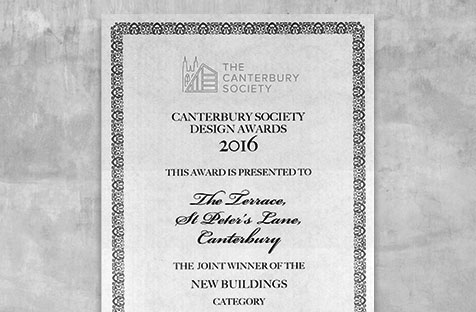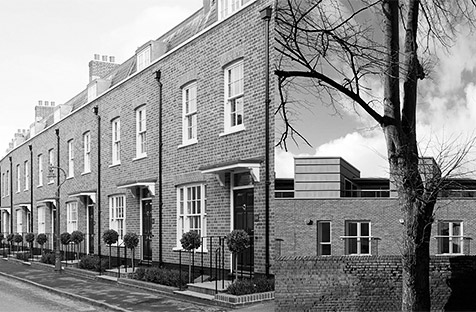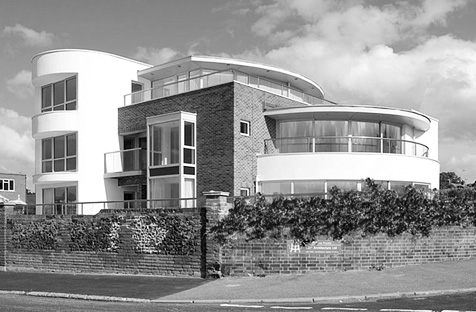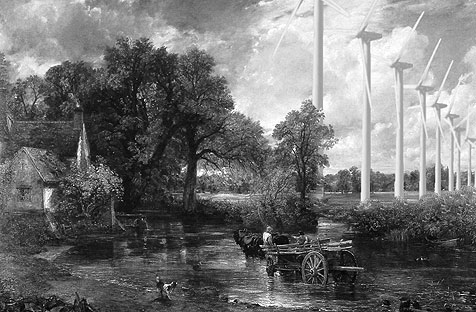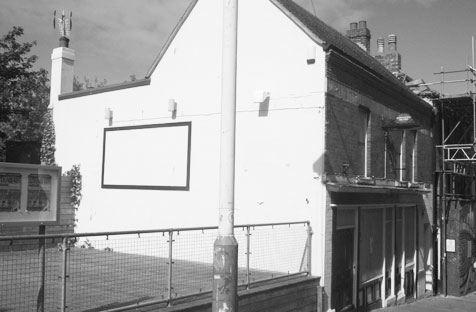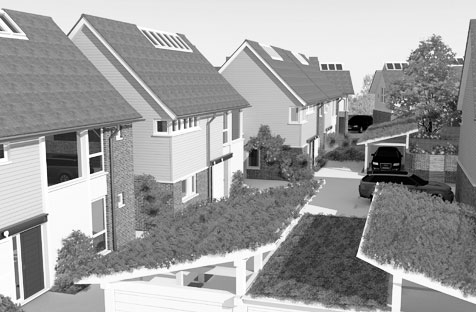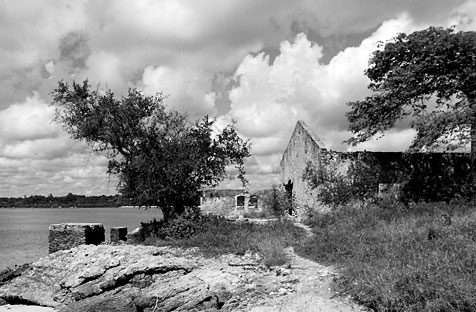St Peters Lane wins best new build
Last week our St Peters Lane housing project won best new build at the 2016 Canterbury Society Design Awards. Presented by TV conservationist Ptolemy Dean, the project was praised for excellent design and detailing and also ‘great brickwork’.
St Peters Lane shared the best new build award with the University of Kent’s £20m library extension and the overall award this year went to the community restoration of Westgate Hall.
St Peters Lane Nominated
We are delighted to announce that our project at St Peters Lane, Canterbury for Rogate has just been nominated for the Canterbury Society Design Award. Thirteen nominated projects will be on display at St Peters Methodist Church and the awards ceremony will take place on 23 March.
Another bafta winning performance!
Sometime last year we agreed to film this promotional video for Blurb. It was a bit of a fun day and to be honest we had all forgot about it. Having not heard anything for a few months we assumed the idea had been shelved but by accident looking on the internet we found this!
When asked if this was timber framed? ‘do you mean the building or the performance,’ came the reply!
Why did the chicken cross the road?
Have you ever wondered about the most profound questions in life like… Why did the chicken cross the road? or… Should we be trying to reduce the amount of CO2 in the atmosphere?
Green Peace Co-founder Dr Patrick Moore has thrown something of a spanner in the works with his latest comments on the amounts of Carbon in the atmosphere.
The new study claims: ‘Abrupt increase’ in CO2 absorption slowed global warming: Excerpt: ‘The earth would have warmed faster in the last two decades had there not been an unexplained rise in the amount of carbon dioxide being absorbed on land, scientists believe.” Scientists have discovered an “abrupt increase” since 1988 in the uptake of carbon dioxide (CO2) by the land biosphere, which comprises all of the planet’s plant and animal ecosystems…the breakthrough had taken scientists “completely by surprise”…[study] explains how much CO2 is absorbed by plants and animals, with some of the CO2 then being passed from plants into the land.” [End study excerpt]
Ecologist Dr. Moore pulled no punches in commenting on the new study: “These people are either completely naive about the relationship between CO2 and plants or they are making this up as a way of deflecting attention from the lack of warming for the past 15 years.” Moore is the author of the book, “Confessions of a Greenpeace Dropout: The Making of a Sensible Environmentalist,” in which he exposes the green movement and explains why he left the organization.
Moore told Climate Depot: “Plants grow much faster when CO2 is higher, the optimum concentration is between 1500-2000 ppm so there is a long way to go before plants are happy. CO2 levels in the atmosphere have continued to rise despite plants absorbing more CO2. So what is the ‘scientists’ point? It is to obfuscate, confuse, and otherwise muddy the waters with disinformation.
Moore continued: “We should challenge them to admit that CO2 is the most important nutrient for all life on earth and to admit that it is proven in lab and field experiments that plants would grow much faster if CO2 levels were 4-5 times higher in the atmosphere than they are today. This is why greenhouse growers pipe the exhaust from their gas and wood heaters back into the greenhouse to increase CO2 levels 3-5 times the level in the atmosphere, resulting in 50-100% increase in growth of their crops. And they should recognize that CO2 is lower today than it has been through most of the history of life on earth.
“There is no ‘abrupt’ increase in CO2 absorption, it is gradual as CO2 levels rise and plants become less stressed by low CO2 levels. At 150 ppm CO2 all plants would die, resulting in virtual end of life on earth.
“Thank goodness we came along and reversed the 150 million-year trend of reduced CO2 levels in the global atmosphere. Long live the humans,” Moore concluded.
St Cecilia’s Complete!
Late Wednesday Thanet planning committee members and senior officers visited the newly completed West Bay Apartments at St Cecila’s Westgate. Much praise was heaped on the Design and completed Building. Congratulations to all involved.
Genius & Common Sense
Genius & Common Sense – A Rare Commodity When It Come To Energy Policy
Two scenes from my middle-class childhood in England. In my home in Winchester, coming wet and cold into the nursery after the obligatory daily outing, I sit on the rug in front of the red glowing gas-stove and quickly get warm and dry. In the Albert Hall in London, in a posh seat in the front row of the balcony, I listen with my father to a concert and hear majestic music emerging out of yellow nothingness, seeing neither the orchestra nor the conductor, because the hall is filled with London‘s famous pea-soup fog. The gas-fire was the quick, clean and efficient way to warm our rooms in a damp climate. The fog was the result of a million open grate coal fires heating rooms in other homes. In those days the gas was coal-gas, with a large fraction of poisonous carbon monoxide, manufactured locally in gas-works situated at the smelly and slummy east end of the town. Since those days, the open-grate coal fire was prohibited by law, and the coal-gas was replaced by cleaner and safer natural gas. London is no longer the place where your shirt-collar is black with soot at the end of each day. But I am left with the indelible impressions of childhood. Coal is a yellow foulness in the air. Gas is the soft purring of the fire in a cozy nursery.
In America when I raised my own children, two more scenes carried the same message. In America homes are centrally heated. Our first home was heated by coal. One night I was stoking the furnace when a rat scuttled out of a dark corner of the filthy coal-cellar, and I killed him with my coal-shovel. Our second home was heated by oil. One happy day, the oil-furnace was replaced by a gas-furnace and the mess of the oil was gone. We were then told that the supply of natural gas would last only thirty years. Now the thirty years are over, but shale gas has extended the supply to a couple of centuries. While the price of oil goes up and up, the price of gas goes down. In America, coal is a bloody fight in the dark. Gas is a clean cellar which became the kids‘ playroom. The most important improvements of the human condition caused by new technologies are often unexpected before they happen and quickly forgotten afterwards. My grandmother was born around 1850 in the industrial West Riding of Yorkshire. She said that the really important change in working-class homes when she was young was the change from tallow candles to wax candles. With wax candles you could read comfortably at night. With tallow candles you could not. Compared with that, the later change from wax candles to electric light was not so important. According to my grandmother, wax candles did more than government schools to produce a literate working class. Shale gas is like wax candles. It is not a perfect solution to our economic and environmental problems, but it is here when it is needed, and it makes an enormous difference to the human condition. Matt Ridley gives us a fair and even-handed account of the environmental costs and benefits of shale gas. The lessons to be learned are clear.
The environmental costs of shale gas are much smaller than the environmental costs of coal. Because of shale gas, the air in Beijing will be cleaned up as the air in London was cleaned up sixty years ago. Because of shale gas, clean air will no longer be a luxury that only rich countries can afford. Because of shale gas, wealth and health will be distributed more equitably over the face of our planet.
Freeman Dyson, 22 April 2011
World-renowned theoretical physicist Freeman Dyson FRS, is Professor Emeritus and Chair of Mathematical Physics and Astrophysics at the Institute of Advanced Study in Princeton and the greatest scientist never to win the Nobel Prize.
In The Headlines
The government has this week finally published its Draft National Planning Policy Framework, which can be read online here.
50 years of planning policy condensed down into 50 pages designed to allow Britain to develop its way out of recession. What does it all mean? Well it depends on your point of view, here are just a few comments……
BPF: The British Property Federation ‘Welcomes the focus on economic growth’
Sir Stewart Lipman ‘We support the strategies of the Framework which we feel will provide a more effective planning system. It will have regard for a balance of the interests of the community, the environment and the growth agenda’
CPRE Campaign to the Protection of Rural England ‘The countryside is under attack’
The Daily Mail Says…… ‘Prince Charles, he’s just a snake oil salesman!!’ and ‘it’s an out of town free-for-all’.
RTPI The Royal Town Planning Institute ‘It fails to set out a vision for the development that is needed to support a growing population and to promote economic growth across the country and that is effectively linked with infrastructure to redress existing and potential geographical and social disparities’ [sic- Maybe its not just the policy that needs changing!]
The emphasis on development is more positive under this draft framework, but as local authorities produce their development plans in response, one can’t help thinking the impact of the Localism Bill will create conflict. So much of this document depends on the interpretation of ’sustainable development’.
New Employee
Helen Merrell joins CDP as our new Office Administrator.
“My job will be to continue to keep the well oiled CDP machine on the rails and moving forward! With a skill set in both languages and administration and a passion for learning new fields, I am looking forward to working with the team and getting to grips with the world of architecture.
Shortlisted for the 2011 RIBA Downland Prize
CDP developed a design strategy for The Creative Foundation to convert, renovate and extend the Earl Grey, a derelict building in the Old High Street at Folkestone. The proposal included residential on the first floor, a restaurant at street level and commercial kitchens and services below ground.
The existing building fabric was retained with contemporary additions at the rear, side and front. A curving side addition, frames the views to the rear, and a panoramic northern window to the studio flat overlooks Payers Park.
Glass doors from the restaurant allow access to the theatrical deck, covered by an elegant canopy and signposted with stainless steel kiosk. These are washed in coloured light, to create an iconic, useable and flexible place which will serve as a new focal point for the Creative Quarter and wider community alike.
Judging of shortlisted entries gets underway in August and awards will be presented at the RIBA in November.
Sustainability For Small Housebuilders
Housebuilder Environ Communities has pledged to build greener homes, starting at Keeper’s Court in Kings Hill. Here, the team behind the project explain what that means.
Wiltshire based housebuilder, Environ Communities has pledged to make its homes more sustainable, not only for environmental reasons, but because it believes the approach makes good business sense.
Executive chairman Tony Dowse says sustainability is a way of giving its homes a premium in a tough market, and believes energy efficiency in particular will become increasingly important as a differentiator in the housing market: “Fuel prices will rise and we think it’s essential to provide a house with minimum running costs. Fuel prices will make people start looking for houses that are economical to live in.”
The housebuilder was no slouch in the green building stakes before taking this stance, having picked up a number of awards for sustainable development for its innovative schemes at Kings Hill in West Malling. The company developed the Lacuna scheme there using Canadian Super E timber technology, and reverted to traditional construction for its Oaks Hamlet phase. With its upcoming Keepers Court phase of 10 houses, however, the firm is making a clear statement about the way it is developing its product.
What does the buying public want?
The homes are designed by CDP Architecture to Code for Sustainable Homes level 4 and near Passivhaus standard, which might be considered cautious for a developer that is marketing sustainability. But Dowse believes the buying public will appreciate many facets of sustainability: “We’ve got to find a way to be sustainable and give the customers what they want. A sustainable house is one that isn’t toxic and is low maintenance, for example.”
Like many in housebuilding, Dowse is an advocate of the ‘fabric first’ approach, saying: “The Swedes have had it right for years in focusing on the fabric. It’s easy to over-complicate matters.”
The company has decided to build both walls and roofs of the homes using Kingspan’s TEK structural insulated panels (SIPs). Windows will be fixed on site. Dowse says timber frame will be the build method of choice from now on: “What appeals to us with timber frame is the speed. Our land holding time and finance costs for the build are significantly reduced. We can put in the foundations and infrastructure and then call off units according to our sales rate.”
There’s another reason for making a shift to modern methods of construction, he adds. “Every year it gets harder and harder to build traditionally and get quality of build.”
The architect has not used the Kingspan system before, but director Andrew Tull sees benefits: “With SIPs we’re getting engineering and flexibility. It has an integrity about it.”
The homes have been designed for manufacture, being based on a ‘nucleus unit’ that has additions according to its location on the site. Tull says: “The rigidity of timber frame can create certain constraints if you are creating open plan layouts. There are limitations. You want to use a system, but you don’t want to be dominated by it. It is simply something you need to bear in mind.”
Dowse describes his new housebuilding approach as “a systems component approach” rather than a manufactured home. He chooses those words because, he says “we’re still not into the concept of housing being a factory-produced product.”
Tull suggests why that might be the case: “One of the issues in this country is that it’s relatively small and housing density is fairly high, so standard systems limit your ability to maximise land value. Land values are so high.”
The SIPs roof panels do help to maximise land value by providing usable lofts. That is another sustainable feature, says Dowse. Keep the house simple. The homes are heated largely using a Paul Campus 500 mechanical ventilation with heat recovery (MVHR) unit, with integral electric heater battery. Water is warmed by immersion heater.
The housebuilder is trialling a Velux solar panel/thermal hot water generation system on one home, but is generally not fitting renewable energy technologies. Instead it is installing a quadruple Velux to let in maximum daylight and allow for solar/photovoltaic technology to be integrated easily later.
There are a host of other consumer-friendly green features from electric vehicle charging points to green roofs on the carports, but the scheme as a whole is light on technology. That’s exactly the intention, says Dowse. While he and Tull are happy to be trialling the Velux product, they have some concerns about over-reliance on technologies. Tull says: “Everything is moving so fast. An M&E consultant has one message one day, and a different one the next. Performance characteristics aren’t tested over the long term. It is difficult when you are trying to plan for the life of a house.”
Dowse agrees: “It is difficult to feel you’re getting the right advice. We ask where products have been used and how they have been used. We’ve learned it is no good compromising. You have to go for the best solution.”
Interview by Jo Smit, editor of Building4change.com
Developments in Tanzania
CDP have received instructions for a residential development in a coastal location in Tanzania. Malaria and Yellow Fever are just some of the issues to overcome!
Sustainable construction raises a whole new set of challenges in this type of environment. When you design you need to fully understand the logistical issues that limited infrastructure in remote locations impose on a project. Just back from a site visit, Andrew Tull said ‘Surveying in blistering heat is challenging……………. It’s not all gin and quinine’.
A Heated Exchange In The Architect’s Journal
Title: Is global warming hot air? Date of Issue: 13 Jan 2011
At the end of last year the price of natural gas fell to the lowest price in December since 2001.
Yet on top of some of the most expensive domestic energy anywhere, UK consumers are soon to pay another £500 a year to subsidise our suicidal green energy policy. Future generations are destined to pay for more idle wind farms, doomed renewable experiments and the latest blind dash into nuclear energy production.
The Cancun circus on global warming last month again showed us the monster we have created. A parallel universe that spews ridiculous statements like “man will control the earth’s temperature to within two degrees”. Yet, despite a new government, we are still destined to mortgage our descendants to support this nonsense.
In the meantime, the so-called scientific consensus on man-made global warming is looking short on evidence and is effectively propped up by dubious computer modelling, the raw data from which nobody seems to want scrutinised too closely.
Our industry has spent the last 20 years or so trying to create energy out of fresh air, desperately trying to re-invent the laws of physics while the architectural profession has built numerous ugly, green-looking eco-buildings to spread the gospel. Has this resulted in the expansion of useful renewable-energy technology? No, but in the last five years, gas extraction technology has developed so fast that we now have enough known reserves spread worldwide to serve us for the next 100 years.
We must build cost-effective, efficient, low-energy buildings. But why, when we have worldwide gas reserves and anthropogenic global warming is far from certain, when I programme in a highly efficient, simple, maintainable, controllable gas boiler into a SAP calculation for a new house, does it spit it out and force me to specify the latest “renewable” toy: an untried, untested, unserviceable electric gadget supported by a priceless photovoltaic that my great, great granddaughter will still be paying for.
If we don’t come to our senses quickly, this country will have fuel poverty on an unthinkable scale. The emperor really does have no clothes on. The problem is, we can’t see him in the dark.
Andrew Tull, RIBA member, Canterbury, Kent
Title: Heated global warming – Date of Issue: 24 Feb 2011
I wonder what qualifies Andrew Tull, RIBA member (AJ 13 01 11), to write on “global warming”. If his opinions were personal, the AJ might have been well advised to leave them private. If they were professional, they might be construed as being in breach of the ARB’s Code of Conduct.
Michael Woodman-Smith, Atelier Woodman, Bristol
Title: Still heated – Date of Issue: 10 March 2011
Sadly Michael Woodman-Smith’s attitude (AJ 24 02 11) demonstrates with tremendous clarity the point I was making. The day that questioning “facts”, “opinions” or so-called “consensus” becomes a breach of the ARB code of conduct, he can be assured I will happily see my name removed from the register.
Andrew Tull, partner, CDP Architecture, Canterbury, Kent
